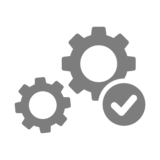Hydraulics goes IO-Link Tailor-made control technology for your hydraulic drive tasks
Our answer to the growing need for smart data: where sensors and actuators still frequently communicate with the machine control system in analogue form, IO-Link quickly and easily builds a digital bridge and is an essential step towards greater efficiency and machine availability. Rely on our smart components and solutions with internationally standardised IO-Link interfaces. Discover our IO-Link functionality.
Into the future with HYDAC: creating digital added value via IO-Link
Increase your machine availability now: from IO-Link sensors to IO-Link capable components and systems – contact our experts for your needs-based IO-Link solution.
The future-proof interface solution: IO-Link
Unlike in analogue systems, the digital IO-Link communication protocol allows other information to be transmitted in addition to process data. This gives you relevant data on the value status and error messages about potentially dangerous events as well as a lot of information on the device itself, e.g. ID, operating parameters or diagnostics. Thanks to bidirectional communication with sensors and actuators at the lowest field level, IO-Link enables services such as remote diagnostics, remote maintenance and predictive maintenance. Benefit from our portfolio of IO-Link sensors and IO-Link capable components and systems. You can find more information on IO-Link functionality in our FAQ.
Our solution: tried and tested hydraulics combined with modern IO-Link technologyAt HYDAC, hydraulic expertise and electronic expertise in automation go hand in hand
HYDAC supplies application-specific IO-Link sensors for your hydraulic machines. This paves the way for the automation of further processes and creates relevant added value for your applications.
This makes the differenceHow you benefit from our HYDAC experts' expertise
Electronics expertise combined with hydraulic know-how: with 60 years of expertise in hydraulic components and applications, we are able to offer you sensors which are suitable for more than just automation. Our sensors also generate valuable, smart product data and application-specific data which can be called up at any time via IO-Link. Hydraulics tasks are already solved and available for you on a turnkey basis with our smart IO-Link sensors.
For quick and easy integration into your controller, we also provide you with Siemens S7 and CODESYS function modules.
Our product range: with HYDAC IO-Link solutions, you can network your systems flexibly From smart pressure transmitters to intelligent ball valves
HYDAC smart pressure transmitter HPT 1000Smart
In addition to its primary task of providing measurements for the system control, the smart pressure transmitter HPT 1000S provides you with a load profile of the hydraulics usage at any time. Problems can be detected early and damage and downtimes are avoided. The monitoring data & diagnostic data stored in the pressure transmitter also increases service efficiency.
HYDAC Virtual Fluid Lab
Do you want to make the most of your filter's potential service life, reduce material costs and service costs and protect the environment? Our IO-Link capable sensor HYDAC VFL monitors the pressure at the filter and gives an estimation of the remaining filter service life. Thanks to IO-Link sensors, the remaining filter service life of your systems is available at any time for your predictive service planning.
HYDAC CO1S smart compact power unit
Protect yourself against unplanned maintenance work and machine failures: our smart compact power unit monitors the use of the hydraulics and itself. The CO1S informs the machine about irregularities and their cause. This increases the availability of your machines and allows maintenance to be planned and implemented in a targeted manner. Reap the benefits of higher machine availability – Contact our experts.
HYDAC ball valve with a pneumatic actuator and position monitoring
With continuous position feedback: thanks to an integrated position sensor with an IO-Link interface, you have all your process values at a glance. Whether it's switching time monitoring, cycle counters or LED displays of operating states – we simplify and optimise your machine architecture with our smart components.
HYDAC valves with sensors and digital control electronics (IO-Link type A and B)
Communication via IO-Link offers you added value, especially in terms of continuously monitoring the condition of our valves. In addition to diagnostic information, it also gives you the option of remote maintenance and provides relevant information over the entire life cycle. You can also simplify complex parameterization – HYDAC valves with digital control electronics and integrated sensors allow you to implement smart additional functions using the software in addition to monitoring and error messages.
HYDAC's smart p0-Guard for intelligent accumulator monitoring
Two functions in one component: over time, hydraulic accumulators can lose their gas charge. With the EDS 3400 smart pressure sensor with integrated accumulator monitoring, you don't need a separate sensor for gas measurement: with smart data interpretation, the EDS 3400 measures the gas pre-charge pressure at the same time as the oil pressure. This increases your system's safety and detects gas leaks faster. This saves valuable time and makes maintenance easier to plan - for long-term cost savings.
Your advantages: IO-Link enables…
FAQ What you need to know about IO-Link
What is IO-Link functionality?
- IO-Link is the first worldwide standardised I/O technology in accordance with IEC 61131 9
- IO-Link is a bi-directional communication system for the connection of smart sensors and actuators in an automation system
- IO-Link is a digital point-to-point connection
- IO-Link enables coded switching - "0" = 0V, "1" = 24V
- IO-Link is not a field bus. It's a digital signal
- IO-Link can communicate with any fieldbus via corresponding IO-Link masters
- IO-Link uses established and tried-and-tested connection technology for sensors and actuators
What components use IO-Link?
In addition to the components using IO-Link, i.e. sensors or actuators, IO-Link requires one or more IO-Link masters as central networking nodes for IO-Link components and fieldbuses. All point-to-point connections are physically implemented with unshielded standard cables, with the maximum cable length being 20 meters. A special SW module is used to set up an IO-Link network.
What data types are used in an IO-Link network?
Various data types with differing communication directions and time intervals can be used in IO-Link networks:
Process data
- Pressure, temperature, fluid level, etc.
- Cyclic transmission
- Typical cycle time e.g. for COM 2 (38.4 kBit /s) for 2 bytes: approx. 2.5 ms
- Up to 32 bytes (input/output) per cycle
Value status
- Port qualifier
- Verification of data
- Cyclic transmission with the process value
Events
- Error messages (e. g. short circuit)
- Warnings
- Maintenance data (e.g. contamination, overheating)
- Acyclic transmission
Device data
- Manufacturer ID, device ID, "electronic data sheet"
- Device parameters and settings
- Read / write
- Diagnostics & smart data
- Acyclic transmission on request
What does the architecture of automation with IO-Link look like?
HYDAC IO-Link sensors generate smart data for a wide range of tasks in hydraulics. The system sends valuable information on processes and usage which helps machine operators to increase machine availability and lengthen maintenance intervals.
What are the advantages of IO-Link?
- Simple, uniform wiring and a significantly reduced variety of interfaces on the sensors/actuators
- Standardised, uniform interface for sensors and actuators regardless of their complexity (switching, measuring, multi-channel binary, mixed signal)
- This reduces the number of variants required as well as the storage
- Rapid commissioning
- Reduced space requirements
- Any combination of IO-Link devices and sensors/actuators without IO-Link on the IO-Link master
- Dynamic changes in the sensor actuator parameters by the controller or the operator on the HMI
- Reduction in downtimes when products are replaced
- Automatic reparameterisation when devices are replaced during operation
- Minimal downtimes
- Devices can be replaced by untrained staff without additional tools
- Prevention of misadjustments
- End-to-end device identification
- Identification of installed devices
- Machine quality is ensured when replacing equipment
Is a mixed operation of IO-Link devices and standard switches possible?
Yes. Mixed operation is possible in a system, as each IO-Link device also supports conventional switching operation in accordance with the specification. With IO-Link, both an IO-Link sensor can be easily operated on a conventional digital control input and, conversely, an existing binary sensor with PNP switching output can be connected to an IO-Link input
Is IO-Link more expensive than traditional technology?
When taking just the hardware into account, IO-Link sensors are not more expensive than comparable conventional sensors with the same performance. The costs of an IO-Link port are similar to those of a conventional analogue channel. However, if you also take into account the wiring costs saved and the reduced downtimes, the savings potential can add up to up to 60%, depending on the application.


